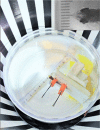The Effect of Zeaxanthin on the Visual Acuity of Zebrafish
- PMID: 26267864
- PMCID: PMC4534338
- DOI: 10.1371/journal.pone.0135211
The Effect of Zeaxanthin on the Visual Acuity of Zebrafish
Abstract
Oral supplementation of carotenoids such as zeaxanthin or lutein which naturally occur in human retina have been shown to improve vision and prevent progression of damage to advanced AMD in some studies. The zebrafish eye shares many physiological similarities with the human eye and is increasingly being used as model for vision research. We hypothesized that injection of zeaxanthin into the zebrafish eye would improve the visual acuity of the zebrafish over time. Visual acuity, calculated in cycles per degree, was measured in adult zebrafish to establish a consistent baseline using the optokinetic response. Zeaxanthin dissolved into phosphate buffered saline (PBS) or PBS only was injected into the anterior chamber of the right and left eyes of the Zebrafish. Visual acuities were measured at 1 week and 3, 8 and 12 weeks post-injection to compare to baseline values. Repeated measures ANOVA was used to compare visual acuities between fish injected with PBS and zeaxanthin. A significant improvement in visual acuity, 14% better than before the injection (baseline levels), was observed one week after injection with zeaxanthin (p = 0.04). This improvement peaked at more than 30% for some fish a few weeks after the injection and improvement in vision persisted at 3 weeks after injection (p = 0.006). The enhanced visual function was not significantly better than baseline at 8 weeks (p = 0.19) and returned to baseline levels 12 weeks after the initial injection (p = 0.50). Zeaxanthin can improve visual acuity in zebrafish eyes. Further studies are required to develop a better understanding of the role zeaxanthin and other carotenoids play during normal visual function.
Conflict of interest statement
Figures




References
-
- Handelman GJ, Dratz EA, Reay CC, van Kuijk JG. Carotenoids in the human macula and whole retina. Invest Ophthalmol Vis Sci. 1988;29(6):850–5. Epub 1988/06/01. . - PubMed
Publication types
MeSH terms
Substances
LinkOut - more resources
Full Text Sources
Other Literature Sources
Molecular Biology Databases

